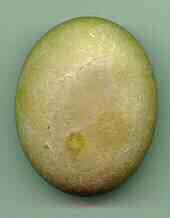|
Enteroliths are stones that form around a foreign objects in the
intestine of horses. They develop similarly as a pearl develops around
a grain of sand in an oyster. Most enteroliths seems to form around small
bits of metal or wood which the horse ingests and which don't pass through.
Research suggests that enteroliths are more prolific when the digestive tract is high in phosphorus and high pH. Smaller enteroliths will usually pass through the intestine. If they don't, they grow larger and will eventually result in a fatal colic unless surgically removed.
Obviously if your horse is passing smaller enteroliths, larger ones should be suspected. Other signs include abdominal discomfort and recurrent, chronic low
grade colic with no other logical cause.
The UC Davis School of Veterinary Medicine and other major veterinary institutions seem to agree on some key elements of prevention.
- Cut down on alfalfa. Nearly all the horses experiencing enteroliths had a
diet consisting of at least 50% alfalfa. Grass or oat hay is preferred.
- Reduce or eliminate bran from your horse's diet. Bran contains high levels of
phosphorus which are linked to enterolith formation.
- Increase grain ratio (within reason). Additional grain will decrease the pH
level in the colon.
- You can add one cup of vinegar a day to your horse's diet. This will help
decrease intestinal pH levels.
- Provide grazing or increased feedings to three or fours times a day. This
will maintain a more steady movement of bulk material through the colon.
- Use straw for bedding instead of shavings. Some horses will nibble on straw
which provides constant low protein fiber.
- Provide occasional doses of psyllium mucciloid to improve bulk movement. Introduced bulk can help move both small enteroliths and the foreign objects
around which they form.
- Provide consistent and frequent exercise. Exercise keeps the digestive system
moving. Confinement tends to slow the process down.
 The enterolith pictured here came out of Phil West's horse, Bigun. Phil indicates that this was one of the smaller ones, measuring 1-3/4" Long x 1-5/8" Wide x 5/8" Thick. He destroyed the others, breaking them open to see what was in the center. In Bigun's case, in the center of each was a piece of wood that he ingested (somewhere), that was about a half in inch in length.
The enterolith pictured here came out of Phil West's horse, Bigun. Phil indicates that this was one of the smaller ones, measuring 1-3/4" Long x 1-5/8" Wide x 5/8" Thick. He destroyed the others, breaking them open to see what was in the center. In Bigun's case, in the center of each was a piece of wood that he ingested (somewhere), that was about a half in inch in length.
Press Back to return to the page which brought you here
KBR Horse Health Information, © 1997 Lamm's Kickin' Back
Ranch and Willis & Sharon Lamm. All rights reserved. Duplication of any of this material for
commercial use is prohibited without express written permission. This prohibition is
not intended to extend to personal non-commercial use, including sharing with others for
safety and learning purposes, provided this copyright notice is attached.
Email us to submit comments or request reproduction
permission.
|

